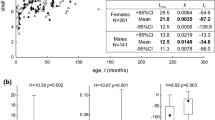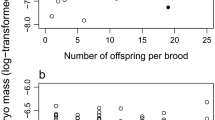Summary
Age specific fecundity and size of offspring were compared in two populations of Viviparus ater, one from Lake Zürich (Switzerland) and one from Lake Maggiore (Italy). Females were caged and their offspring sampled at weekly intervals. Average fecundity per female over one year was 19.6 and 14.7 offspring in Lake Zürich and Lake Maggiore, respectively. Average shell widths of offspring at birth in the two lakes were 8.5 mm and 7.4 mm. Fecundity did not change with age in Lake Zürich but decreased with increasing age of the snails in Lake Maggiore. Fecundity and offspring size were positively correlated with the size of the females in both lakes, but fecundity was higher and offspring were larger in Lake Zürich than in Lake Maggiore irrespective of the size of the females. An analysis of covariance, correcting for differences between the two lakes in the total fresh weight of the offspring produced annually, showed that females from the two lakes distributed their reproductive investment differently. Females in Lake Zürich produced relatively fewer but larger offspring than females in Lake Maggiore. This trade-off was hidden because females in Lake Zürich produced twice as much offspring biomass as females in Lake Maggiore. The possibility that different selection regimes might account for the observed differences is discussed.
Similar content being viewed by others
References
Atkinson WD, Newbury SF (1984) The adaptations of the rough winkle Littorina rudis, to desiccation and to dislodgment by winds. J Anim Ecol 53:93–105
Barbato G (1971) Studio sul comportamento stagionale di Viviparus ater (Crist. and Jan) dei laghi d'Iseo e di Garda (Gastropoda, Viviparidae). Natura 62:65–74
Begon M (1985) A general theory of life-history variation. Behav Ecol Symp Brit Ecol Soc 25:91–97
Berven KA (1982) The genetic basis of altitudinal variation in the wood frog Rana sylvatica. I. An experimental analysis of life history traits. Evolution 36:962–983
Brockelman WY (1975) Competition, fitness of offspring, and optimal clutch size. Am Nat 109:677–699
Brown KM (1983) Do life history tactics exist at the intraspecific level? Data from freshwater snails. Am Nat 121:871–879
Brown KM (1985) Intraspecific life history variation in a pond snail: the roles of population divergence and phenotypic plasticity. Evolution 39:387–395
Browne RA (1978) Growth, mortality, fecundity, biomass and productivity of four lake populations of the prosobranch snail, Viviparus georgianus. Ecology 59:742–750
Calow P (1978) The evolution of life-cycle strategies in fresh-water gastropods. Malacologia 17:351–364
Caswell H (1983) Phenotypic plasticity in life-history traits: demographic effects and evolutionary consequences. Am Zool 23:35–46
Charlesworth B (1980) Evolution in age-structured populations. Cambridge University Press, Cambridge, pp 300+XIII
Charlesworth B, Leon JA (1976) The relation of reproductive effort to age. Am Nat 110:449–459
Cole LC (1954) Population consequences of life history phenomena. Q Rev Biol 29:103–137
Cook PM (1949) A ciliary feeding mechanism in Viviparus viviparus (L.). Proc Malacol Soc London 27:265–271
Cummins CP (1986) Temporal and spatial variation in egg size and fecundity in Rana temporaria. J Anim Ecol 55:303–316
Diamond JM (1982) Stream geomorphology and benthic habitat predictability as determinants of the population dynamics and life history of the snail Juga plicifera. J Freshwater Ecol 1:577–588
Dorazio RM, Lehman JT (1983) Optimal reproductive strategies in age-structured populations of zooplankton. Freshwater Biol 13:157–175
Fletcher WJ (1984) Variability in the reproductive effort of the limpet, Cellana tramoserica. Oecologia (Berlin) 61:259–264
Frömming E (1956) Biologie der mitteleuropäischen Süßwasserschnecken. Duncker and Humblet, Berlin
Gallardo CS, Perron FE (1982) Evolutionary ecology of reproduction in marine benthic molluscs. Malacologia 22:109–114
Grahame J (1982) Energy flow and breeding in two species of Lacuna: comparative costs of egg production and maintenance. Int J Invert Reprod 5:91–99
Hart A, Begon M (1982) The status of general reproductive-strategy theories, illustrated in winkles. Oecologia (Berlin) 52:37–42
Helwig JT, Council KA, Reinhardt PS (1979) SAS User's Guide, 1979 edition, SAS-Institute, Raleigh, North Carolina
Herold H (1958) Über die Verbreitung der rezenten Viviparus-Arten, besonders im südwestdeutschen Raum. Jahresheft des Vereins für vaterländische Naturkunde Württemberg 113:143–146
Hornbach DJ, Way CM, Burky AJ (1980) Reproductive strategies in the feshwater sphaeriid clam, Musculium partumeium (Say), from a permanent and a temporary pond. Oecologia (Berlin) 44:164–170
Hutchings JA, Morris DW (1985) The influence of phylogeny, size and behaviour on patterns of covariation in salmonid life histories. Oikos 45:118–124
Istock CA (1967) The evolution of complex life cycle phenomena: an ecological perspective. Evolution 21:592–605
Istock CA (1983) The extent and consequences of heritable variation for fitness characters. In: King CR, Dawson PS (eds) Population Biology. Columbia University Press
Jokinen EH, Guerette J, Kortmann RW (1982) The natural history of an ovoviviparous snail, Viviparus georgianus (Lea), in a softwater eutrophic lake. Freshwater Invert Biol 5:2–17
Pianka ER (1970) On r- and K-Selection. Am Nat 104:592–597
Ribi G, Mutzner A, Gebhardt M (1987) Shell dissolution and mortality in the freshwater snail Viviparus ater. Schweiz Z Hydrol (in press)
Schaffer WM (1974) Selection for optimal life histories: the effects of age structure. Ecology 55:291–303
Schanz F, Thomas EH (1981) Reversal of eutrophication in Lake Zürich. WHO Wat Qual Bul 6:108–112, 156
Sibly R, Calow P (1985) Classification of habitats by selection pressures: a synthesis of life-cycle and r/K theory. Behavioural Ecology. Symp Brit Ecol Soc 25:75–90
Smith CC, Fretwell SD (1974) The optimal balance between size and number of offspring. Am Nat 108:499–506
Spoel S van der (1958) Groei en ouderdom bij Viviparus viviparus (Linné, 1758). Basteria 18:77–87
Spoel S van der (1959) Age-determination by winter rings. Basteria 23:36–38
Stanczykowska A, Magnin E, Dumouchel A (1971) Etude de trois populations de Viviparus malleatus (Reeve) (Gastropoda, Prosobranchia) de la région de Montréal. I. Croissance, fécondité, biomasse et production annuelle. Can J Zool 49:1431–1441
Stearns SC (1976) Life history tactics: a review of the ideas. Q Rev Biol 51:3–47
Tallamy DW, Denno RF (1982) Life history trade-offs in Gargaphia solani (Hemiptera, Heteroptera, Tingidae). The cost of reproduction. Ecology 63:616–620
Thomas EA, Kunz W (1978) Limnologische Untersuchungen im schweizerischen Teil des Lago Maggiore, Herbst 1970 bis Herbst 1977. Vjsch Natf Ges Zürich 123:237–260
Todd CD (1979) Reproductive energetics of two species of dorid nudibranchs with planktotrophic and lecithotrophic larval strategies. Mar Biol 53:57–68
Tuomi J (1980) Mammalian reproductive strategies: a generalized relation of litter size to body size. Oecologia (Berlin) 45:39–44
Vail VA (1978) Seasonal reproductive patterns in 3 viviparid gastropods. Malacologia 17:73–97
Vincent B, Gaucher M (1983) Variations de la fécondité et de la structure des populations chez Bithynia tentaculata L. (Gastropoda: Prosobranchia). Can J Zool 61:2417–2423
Wilbur HM (1977) Propagule size, number and dispersion pattern in Ambystoma and Asclepias. Am Nat 111:43–68
Williams GC (1966) Adaptation and natural selection. Princeton University Press, Princeton
Author information
Authors and Affiliations
Rights and permissions
About this article
Cite this article
Ribi, G., Gebhardt, M. Age specific fecundity and size of offspring in the prosobranch snail, Viviparus ater . Oecologia 71, 18–24 (1986). https://doi.org/10.1007/BF00377314
Received:
Issue Date:
DOI: https://doi.org/10.1007/BF00377314




